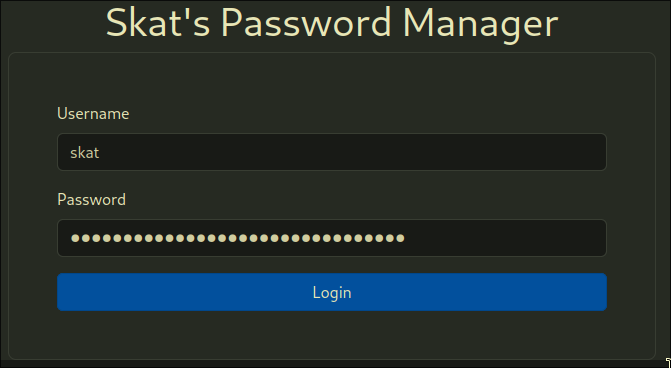|Yoshixis Web|
IrisCTF 2025
Challenges
password-manager
Solved with Flight
Challenge Info
 https://password-manager-web.chal.irisc.tf/
https://password-manager-web.chal.irisc.tf/
Recon
Ok, so we can take a look at the source code
index.js has:
function showAlert(message) {
const alertDiv = document.getElementById('alertMessage');
alertDiv.innerHTML = '<p>' + message + '</p>';
alertDiv.classList.remove('d-none');
}
document.getElementById("submit").onclick = async function() {
fetch("./login", {
method: "POST",
body: JSON.stringify({
usr: document.getElementById("username").value,
pwd: document.getElementById("password").value,
}),
}).then(async (response) => {
const body = await response.text()
try {
JSON.parse(body)
window.location.href = "./passwords"
} catch(_) {
showAlert(body)
}
})
}
- After clicking the submit button, a POST request is sent to https://password-manager-web.chal.irisc.tf/login with a JSON body of usr and pwd corresponding to the username field and password field
- If the response is valid JSON, we are sent to https://password-manager-web.chal.irisc.tf/passwords which is a page that shows all of the user's passwords gotten from a SQL database
main.go has:
package main
import (
"database/sql"
"encoding/base64"
"encoding/json"
"fmt"
"net/http"
"os"
"strings"
"time"
_ "github.com/go-sql-driver/mysql"
)
type CustomMux struct {
handlers map[string]http.HandlerFunc
}
type Auth struct {
User string `json:"usr"`
Password string `json:"pwd"`
}
var DB *sql.DB
var PathReplacer = strings.NewReplacer(
"../", "",
)
var users map[string]string
func NewCustomMux() *CustomMux {
return &CustomMux{handlers: make(map[string]http.HandlerFunc)}
}
func (mux *CustomMux) HandleFunc(pattern string, handler http.HandlerFunc) {
mux.handlers[pattern] = handler
}
func (mux *CustomMux) ServeHTTP(w http.ResponseWriter, r *http.Request) {
rawPath := r.URL.RawPath
if rawPath == "" {
rawPath = r.URL.Path
}
if handler, exists := mux.handlers[rawPath]; exists {
handler(w, r)
} else {
mux.handlers["/"](w, r)
}
}
func main() {
// Connect to MySQL
db, err := sql.Open("mysql", "readonly_user:password@tcp(127.0.0.1:3306)/uwu")
if err != nil {
fmt.Printf("Error connecting to mysql: %v\n", err)
return
}
DB = db
db.SetConnMaxLifetime(time.Minute * 3)
db.SetMaxOpenConns(10)
db.SetMaxIdleConns(10)
// Initialize users var
file, err := os.Open("./users.json")
if err != nil {
fmt.Printf("Error reading users.json: %v\n", err)
return
}
if err := json.NewDecoder(file).Decode(&users); err != nil {
fmt.Printf("Error reading users.json: %v\n", err)
return
}
// Create HTTP server
mux := NewCustomMux()
mux.HandleFunc("/", pages)
fmt.Println("Server starting on :8000")
err = http.ListenAndServe(":8000", rawMux(mux))
if err != nil {
fmt.Printf("Error starting server: %v\n", err)
}
}
func rawMux(handler http.Handler) http.Handler {
return http.HandlerFunc(func(w http.ResponseWriter, r *http.Request) {
handler.ServeHTTP(w, r)
})
}
func login(w http.ResponseWriter, r *http.Request) {
var auth Auth
if err := json.NewDecoder(r.Body).Decode(&auth); err != nil {
w.WriteHeader(http.StatusBadRequest)
w.Write([]byte("Invalid request!"))
return
}
if !validateLogin(auth.User, auth.Password) {
w.WriteHeader(http.StatusUnauthorized)
w.Write([]byte("Invalid password!"))
return
}
authJson, err := json.Marshal(auth)
if err != nil {
w.WriteHeader(http.StatusInternalServerError)
w.Write([]byte("Error occurred! (this should not happen, please open a ticket!)"))
return
}
http.SetCookie(w, &http.Cookie{
Name: "auth",
Value: base64.RawStdEncoding.EncodeToString(authJson),
})
w.Write([]byte("{}"))
}
func validateLogin(user, password string) bool {
if realpassword, ok := users[user]; !ok || password != realpassword {
fmt.Printf("%t | \"%s\"==\"%s\" %t", ok, password, realpassword, password == realpassword)
return false
}
return true
}
func isLoggedIn(w http.ResponseWriter, r *http.Request) (bool, error) {
var auth Auth
authCookie, err := r.Cookie("auth")
if err != nil {
w.WriteHeader(http.StatusInternalServerError)
return false, err
}
data, err := base64.RawStdEncoding.DecodeString(authCookie.Value)
if err != nil {
w.WriteHeader(http.StatusInternalServerError)
return false, err
}
json.Unmarshal(data, &auth)
return validateLogin(auth.User, auth.Password), nil
}
func getpasswords(w http.ResponseWriter, r *http.Request) {
loggedIn, err := isLoggedIn(w, r)
if err != nil {
w.WriteHeader(http.StatusInternalServerError)
fmt.Println(err)
return
}
if !loggedIn {
w.WriteHeader(http.StatusUnauthorized)
return
}
res, err := DB.Exec("SELECT * FROM passwords")
if err != nil {
w.WriteHeader(http.StatusInternalServerError)
fmt.Println(err)
return
}
err = json.NewEncoder(w).Encode(res)
if err != nil {
w.WriteHeader(http.StatusInternalServerError)
fmt.Println(err)
return
}
}
func homepage(w http.ResponseWriter, r *http.Request) {
http.ServeFile(w, r, "./pages/index.html")
}
func notfound(w http.ResponseWriter, _ *http.Request) {
fmt.Fprintf(w, "Hey! No page found!")
}
func pages(w http.ResponseWriter, r *http.Request) {
// You. Shall. Not. Path traverse!
path := PathReplacer.Replace(r.URL.Path)
if path == "/" {
homepage(w, r)
return
}
if path == "/login" {
login(w, r)
return
}
if path == "/getpasswords" {
getpasswords(w, r)
return
}
fullPath := "./pages" + path
if _, err := os.Stat(fullPath); os.IsNotExist(err) {
notfound(w, r)
return
}
http.ServeFile(w, r, fullPath)
}
- Connects to a local SQL database (I tried to connect, but it is limited to the server's IP to connect only)
- Creates a users.json file that stores a json mapping usernames and passwords
- Sets routes to be handled with pages()
- the pages() handles Path Traversal with a replacer
- pages() sets the default root directory to be at index.html, which has the index.js file to handle login requests
- login requests are compared with the data inside users.json
- If the login matches a username and password pair in users.json, returns a valid json object which is just
{}, and runs get_passwords() which queries the SQL database for all the user's passwords - We are then routed to https://password-manager-web.chal.irisc.tf/passwords/ which should display all our passwords nicely
Soln
So, the vulnerability lies inside the replacer function that is supposed to prevent path traversal.
var PathReplacer = strings.NewReplacer(
"../", "",
)
It evaluates the literal and replaces only ../
So, if we still want our string to have ../ capabilites of path traversal, we can pass in our url to be: .../...// which when removed of its ../, we get ../
So, we make the URL be: https://password-manager-web.chal.irisc.tf/.../...//users.json
Now that we have users.json, we can input these credentials directly and get the flag



Zettelkasten
Themes











